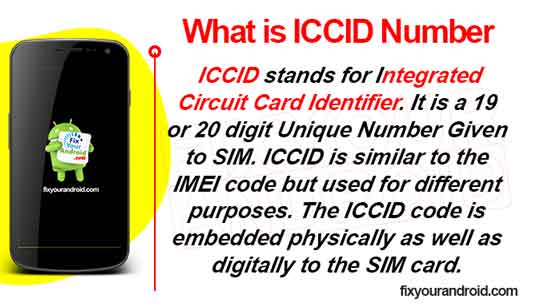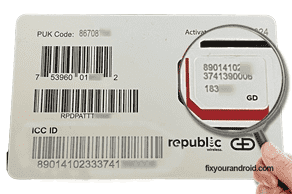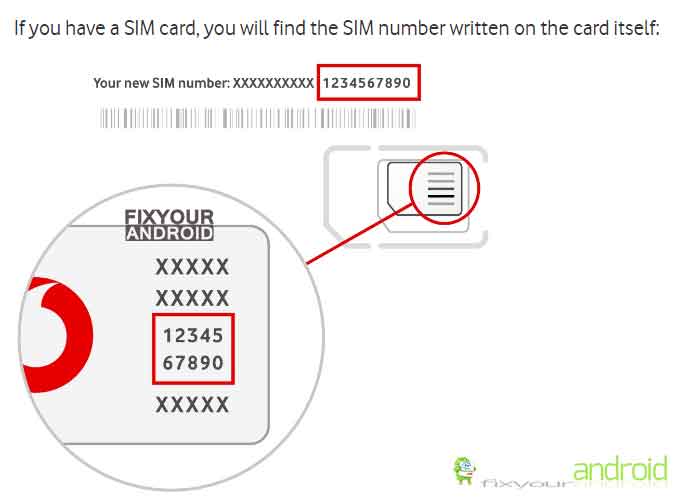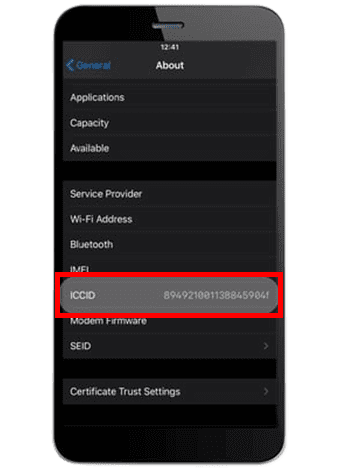ICCID Number is a digital signature for SIM cards globally. It’s a 19 or 20-digit Unique Number Given to SIM universally. It is a SIM card identity that helps the carrier providers to organize and identify the SIM card on the network. Know more about ICCID Number. What does each Digit on ICCID represent and how to interpret the SIM ICCID Number?

What is ICCID Number?
ICCID or Integrated Circuit Card Identifier is a unique identification code for SIM stored under the processor with the purpose of giving a unique identity to the SIM to distinguish one from another.
This ICCID Number is typically 19 to 20 characters long (though it can range from 18 to 22) and can be found printed on the SIM card as well.
This applies to all SIM types including eSIMs, virtual SIM cards and physical SIM cards as well.
The ICCID is a globally unique serial number—a one-of-a-kind signature that identifies the SIM card itself. It stands for Integrated Circuit Card ID, a 19- or 20-digit number that’s typically printed on the back of a SIM card.
What is the purpose of ICCID Number?
The ICCID number of SIM card acts as an identification number of SIM that contains all the information about the SIM like country of origin, carrier provider, SIM card issuer information etc.
This number can help you to track the information about the SIM card. It stands for Integrated Circuit Card ID, a 19- or 20-digit number that’s typically printed on the back of a SIM card.
What do ICCID numbers actually mean?
All the digits in an ICCID number serve a unique purpose and act as a signature of the SIM. The ICCID is a globally unique serial number that can be interpreted to find information about the SIM.
Components of an ICCID Number
An ICCID number follows this format: MMCC-IINN-NNNN-NNNN-NN C(X). It consists of groupings that represent various identifiers and codes, making each SIM card unique.
Read the table below to know how to read and understand the components of an ICCID number.
- The first two digits of ICCID numbers(MM) indicate the telecommunications industry. This number distinguishes the SIM from other types of chip cards, including credit cards and some types of government or business identification.
- The next 2-3 digits of ICCID numbers indicate the country(CC). This code is determined by the International Telephony Union (ITU). This number varies from region or country. These numbers are different from mobile country codes (MCCs) used in IMSIs.
- The next set of digits of ICCID numbers(NNNN) signifies the mobile network code (MNC), its a 1–4 digit identifier of the mobile network that issued the SIM—in other words, its home network.
- The next set of digits of ICCID numbers is a unique number that is different from any other SIM card chip on the planet.
- N is the Account ID: This ID is what truly distinguishes your SIM card from any other SIM card on the world.
- C is a sum: This sum is calculated from all previous digits by applying the Luhn algorithm.
- X is an additional digit: This digit is derived from a command known as ‘AT!ICCID?’, however officially, this number is not considered part of the ICCID.
How do you find an ICCID number?
Typically, the ICCID number can be found in the package of the SIM card.

However, you can find it printed on the back of a SIM card as well.
The ICCID number of a SIM is a unique code. You can roughly compare this to the security number of the SIM in your country that holds all the information about the person or product.
Find ICCID Number Android?
- Open settings on Android.
- Tap on Network settings.
- Now tap on SIM card you want to know the ICCD number for(in case of a dual SIM phone)
- You can find a 19-20 digit number ICCID number listed.
You can also use a SIM Serial Number identifier to find the ICCID number in the case of eSIMs.
Find ICCID Number iPhone?
- Go to Settings, then tap on General.
- Tap on About. Scroll down until you see under your carrier information the ICCID of your SIM card.
Read Also: What is My Phone Number? Easy Methods to Find Phone Number
Other Numbers Used With Mobile Network Equipment
Besides the ICCID number, there are several other code or numbers on a SIM card that serves different purposes which are UPC, Part number, SKUs, IMEI, IMSI, LAI etc.
All these have their own purposes on a SIM which are as follows;
International Mobile Subscriber Identity (IMSI)
The IMSI or International Mobile Subscriber Identity is usually a 15-digit number, that is used to identify the connectivity of services like subscriptions and all. This unique code identifies the user on the network to establish the connection. The IMSI is different from IMS services and IMS logger.
It’s different from the ICCID, which is used to identify SIM hardware and not connectivity. The IMSI is usually a 15-digit number, though it may be shorter.
Read Also: What is IMS Service? Understand IMS Service on Mobile Device
International Mobile Equipment Identity (IMEI)
The IMEI is a unique identifier for every device. This number however, doesn’t play any role in SIM card services but it helps the device identify the device and register it to the network.
IMEI stands for International Mobile Equipment Identity, a unique number for all the smart devices that use any kind of cellular services including smartphones.
This number not only provides a unique identity but also help the carrier providers to use the IMEI to determine if the device has even been certified for use on their network, and will prevent devices that have not been certified.
Some manufacturers take a different approach and include the IMEI on the Settings menu in the device’s software application.
When the device is connected, the IMEI is checked against a global IMEI database to identify the device to the network.
An IMEI is usually broken down this way:
- 22-333333-44444-5
- 22 identifies the reporting body
- 333333 is the actual type allocation code (TAC) digits
- 44444 represents the device’s distinctive ID number
- 5 is the check digit
Read Also: Difference between MMI, USSD and SS codes
MSISDN
The Mobile Station ISDN Number (MSISDN) is the complete phone number, including the country code, of a piece of mobile equipment used to complete voice calls and route SMS messages.
Typically, an IMSI has 15 digits: 222-333-444444444
- The first 3 digits (222) of the IMSI are the mobile country code (MCC).
- The next 2–3 digits (333) are the mobile network code (MNC).
- The remaining digits (444444444) identify the line of service, or what’s termed as the subscriber.
Ki and ADM keys
These two codes are used by the network to authenticate a device.
- The Ki key is a cryptographic code associated with a subscriber.
- The ADM key unlocks administrative capabilities—with it, a user can make changes to facets of the software that are typically locked.
Read Also: What Is No SIM Restrictions? How To Check The Status?
OPc
The Operator Code (OPc) is designated for a particular operator and used for key generation. It’s a static code that remains the same for all subscribers and SIM hardware under a particular operator.
EID Number
If you have a device that uses an eSIM, the EID is the unique serial number that’s attached to it. To use an eSIM, a phone also needs an EID (Embedded Identity Document) number.
When you set up a new SIM, you may need to give your carrier your phone’s IMEI 1, IMEI 2, or EID numbers.
Read More: How to Identify Sim Card Carrier on my Phone?
How MNOs use ICCID numbers
The ICCID number on the SIM card plays a vital role for MNO(Mobile Network Operator) to register and recognize the SIM card on the network.
As you insert the SIM card into the device that uses cellular connectivity, it starts searching for the available network, now the ICCID and IMSI come into the role to determine if the device has all the rights to access the network.
If the SIM card doesn’t have the correct key to access the network, the device can only use the network to call emergency services. (Devices can even use this service without a SIM.)
Co-relation of ICCID and IMSI
Initially, the ICCID and IMSI may look similar but they are quite different from each other in terms of identification and usability by MNOs.
A SIM card can have only one ICCID that is required for hardware verification and identification of the SIM. Also, this is a unique code for every SIM card and cannot be changed once assigned.
There can be multiple IMSI on a single SIM card and it also keeps changing as the device changes the location from one network reception to another.
While multi-IMSI SIM cards have been around for a while, the new world of eSIMs and eUICC technology is opening up more possibilities—and confusion—around the ICCID and IMSI.
Effects of embedded SIM technology on ICCIDs
The eSIM or embedded SIM technology is disrupting the cellular or mobile technology business world. Technology has lots of advantages as compared to traditional chip base physical SIM cards.
eSIM (embedded SIM)
An eSIM is a hardware component of the SIM card that is directly soldered on the motherboard of mobile phones or cellular-based devices.
This modern technology of eSIM is more reliable and less memory volatile as compared to traditional chip SIM cards.
In spite of being included and embedded in the phone’s hardware, it acts as a traditional SIM card and also gives the liberty to switch between network subscriptions or SIM profile via eUICC.
Read Also: UICC Unlock | What is UICC Unlock?
eUICC
The embedded Universal Circuit Card or eUICC is a piece of software on the eSIM to provision the SIM profile remotely. With SIM profile provision it is not possible to register the SIM on the network and you might get the SIM not provisioned mm#2 error on the device.
It enables network operators to provision profiles from afar, rather than having to physically remove a card and insert new hardware into the device.
eUICCID
eUICCID came to the surface or developed for eSIM cards. This is quite similar to UCCID on the physical SIMs with the same functionality of profile generation and identification of eSIM on the network.
Understanding cellular connectivity
Cellular connectivity is a complex combination of hardware and software all together. The codes, the radio service and many other factors must be in sync and come all together in order to make the connection possible.
However, it doesn’t affect the end user, but there are dozens of factors and technologies working together to make the connection possible on your device.
Frequently Asked Questions
What Are IoT SIM Cards?
IoT SIM card is similar, it’s different in that it supports IoT devices specifically with their network requirements and unique data consumption rates (check-in rates).
What Is a TAC Number?
The TAC is an eight-digit code that uniquely recognizes a cellular device’s hardware configuration. It is issued by the GSMA and makes up the first eight digits of the IMEI serial number.
What is IMEI Number?
IMEI represents a radio device; i.e., your SIM module inside your phone. This is unique for every SIM module on your phone. It means that a dual-SIM phone must contain two IMEIs in them.
Final Words:
ICCID Number is typically 19 to 20 characters long (though it can range from 18 to 22) globally unique serial number for SIM stored under the processor with the purpose of giving a unique identity to the SIM to distinguish one from another. Typically, the ICCID number can be found in the package of the SIM card.
This is quite different from IMSI and IMEI on the SIM. You can easily find the ICCID Number printed on the SIM card or you can also use the settings on the phone to find the ICCID Number on the device.
WHAT TO READ NEXT?
- MIP 67 Error Code: What is mip 67 error on Android, Boost, Sprint?
- What is Samsung CSC Code | Change CSC on Samsung Devices
- Fixing MMI Code Error | Connection problem or invalid MMI code
- How to Identify Sim Card Carrier on my Phone?
- Ways To Find Who Called You From This Phone Number
- How to Block Caller ID on Android and call from Private Number



